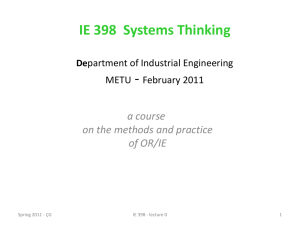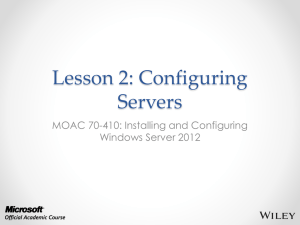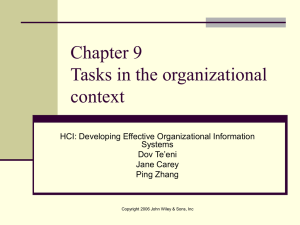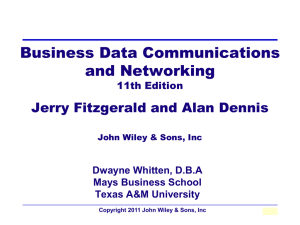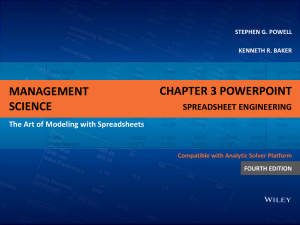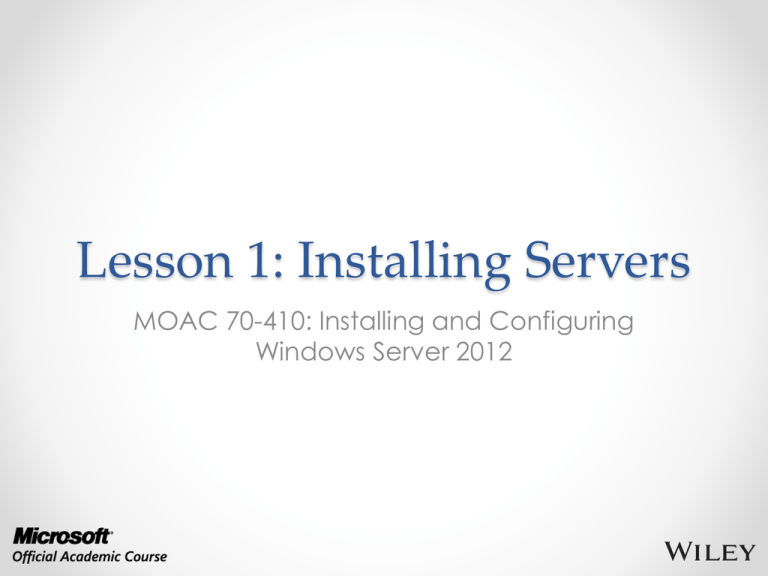
Lesson 1: Installing Servers
MOAC 70-410: Installing and Configuring
Windows Server 2012
Overview
•
•
•
•
•
•
Exam Objective 1.1: Install Servers
Selecting a Windows Server 2012 Edition
Installing Windows Server 2012
Choosing Installation Options
Upgrading Servers
Migrating Roles
© 2013 John Wiley & Sons, Inc.
2
Selecting a Windows Server
2012 Edition
Lesson 1: Installing Servers
© 2013 John Wiley & Sons, Inc.
3
Planning
• The Windows Server 2012 Edition you choose
should be based on multiple factors,
including:
o The roles you intend the servers to perform
o The virtualization strategy you intend to
implement
o The licensing strategy you plan to use
© 2013 John Wiley & Sons, Inc.
4
Windows Server 2012
Core Editions
•
•
•
•
Windows Server 2012 Datacenter
Windows Server 2012 Standard
Windows Server 2012 Essentials
Windows Server 2012 Foundation
© 2013 John Wiley & Sons, Inc.
5
Datacenter
•
•
•
•
Designed for large and powerful servers
Supports up to 64 processors
Fault tolerance—hot-add processors
Only available to purchase through:
o Microsoft volume-licensing program
o Original equipment manufacturers (OEMs),
bundled with a server
© 2013 John Wiley & Sons, Inc.
6
Standard
• Includes the full set of Windows Server 2012
features
• Only differs from Datacenter by the number
of virtual machine instances permitted by
the license
© 2013 John Wiley & Sons, Inc.
7
Essentials
• Includes nearly all features from Datacenter
and Standard editions, except:
o Server Core
o Hyper-V
o Active Directory Federation Services
• Limited to one physical or virtual server
instance
• Maximum of 25 users
© 2013 John Wiley & Sons, Inc.
8
Foundation
• Reduced version of the operating system
designed for small businesses
• Supports only basic server features:
o File and print services
o Application support
• No virtualization rights
• Limited to 15 users
© 2013 John Wiley & Sons, Inc.
9
Supporting Server Roles
Three basic categories of server roles are:
• Directory services
o Store, organize, and supply information about a
network and its resources
• Infrastructure services
o Provide support services for network clients
• Application services
o Provide communication services, operating
environments, or programming interfaces for
specific applications
© 2013 John Wiley & Sons, Inc.
10
Directory Services Roles
Active Directory Certificate Services
Active Directory Domain Services (AD DS)
Active Directory Federation Services
Active Directory Lightweight Directory
Services (AD LDS)
• Active Directory Rights Management
Services (AD RMS)
•
•
•
•
© 2013 John Wiley & Sons, Inc.
11
Infrastructure Services
•
•
•
•
•
•
•
•
•
DHCP (Dynamic Host Configuration Protocol)
DNS Server
Hyper-V
Network Policy and Access Services (NPAS)
Health Registration Authority (HRA)
Remote Access
Volume Activation Services
Windows Deployment Services (WDS)
Windows Server Update Services (WSUS)
© 2013 John Wiley & Sons, Inc.
12
Application Services
•
•
•
•
•
•
Application Server
Fax Server
File and Storage Services
Print and Document Services
Remote Desktop Services
Web Server (IIS)
© 2013 John Wiley & Sons, Inc.
13
Supporting Server
Virtualization
POSE: Physical operating system environment
VOSE: Virtual operating system environment
Edition
POSE Instances
VOSE Instances
Datacenter
1
Unlimited
Standard
1
2
Foundation
1
0
Essentials
1 POSE or VOSE
1 POSE or VOSE
© 2013 John Wiley & Sons, Inc.
14
Server Licensing
Licensing Windows Server 2012 includes
purchasing licenses for both servers and
clients.
Retail
Volume
Licensing
Original
Equipment
Manufacturer
Datacenter
No
Yes
Yes
Standard
Yes
Yes
Yes
Foundation
No
No
Yes
Essentials
No
Yes
Yes
Windows Server Sales Channel Availability, by Edition
© 2013 John Wiley & Sons, Inc.
15
Installing
Windows Server 2012
Lesson 1: Installing Servers
© 2013 John Wiley & Sons, Inc.
16
System Requirements
Minimum system requirements for all editions
of Windows Server 2012:
o
o
o
o
o
Processor: 1.4 GHz 64-bit
RAM: 512 MB
Disk space: 32 GB
DVD or USB flash drive
Super VGA (800 x600) or higher resolution monitor
© 2013 John Wiley & Sons, Inc.
17
Maximum Hardware
Configurations
Windows
Server 2012
Windows
Server 2008 R2
Logical
processors
640
256
RAM
4 terabytes
2 terabytes
Failover cluster
nodes
63
16
© 2013 John Wiley & Sons, Inc.
18
Clean Installation
• Necessary when you have a bare metal
computer.
• Use if you are willing to reformat an existing
disk.
• Creates the most stable environment.
© 2013 John Wiley & Sons, Inc.
19
Performing a
Clean Installation
• Connect and power on all devices.
• Boot from the Windows Server installation DVD.
• Select Language, Time and Currency format,
and Keyboard layout.
• Click Install Now.
• Select your edition of Windows Server 2012.
• Select Custom: Install Windows only
(advanced).
• Select the partition on which to install.
• When the installation is complete, set your
password.
© 2013 John Wiley & Sons, Inc.
20
Performing a Clean Installation
Select Your Preferences
© 2013 John Wiley & Sons, Inc.
21
Performing a Clean Installation
Click Install Now
© 2013 John Wiley & Sons, Inc.
22
Performing a Clean Installation
Select Server Edition
© 2013 John Wiley & Sons, Inc.
23
Performing a Clean Installation
Select Custom: Install Windows only (advanced)
© 2013 John Wiley & Sons, Inc.
24
Performing a Clean Installation
Select the Partition/Drive on which to Install
Windows Server
© 2013 John Wiley & Sons, Inc.
25
Performing a Clean Installation
Set the Administrator Password
© 2013 John Wiley & Sons, Inc.
26
Installing Third-Party
Drivers
• If hard drives are connected to a third-party
controller, rather than the one integrated
into the motherboard, the installation
procedure may not detect your hard drive.
• The Where do you want to install Windows?
page will not list hard drives.
• Install a third-party driver to allow the
installation program access to your hard
drive to continue the installation.
© 2013 John Wiley & Sons, Inc.
27
Working with
Installation Partitions
• You can create, manage, and delete
partitions on your hard drive.
• Click Drive options (advanced) and four
buttons will appear:
o
o
o
o
Delete
Extend
Format
New
© 2013 John Wiley & Sons, Inc.
28
Working with
Installation Partitions
Advanced Drive Options Buttons
© 2013 John Wiley & Sons, Inc.
29
Choosing Installation
Options
Lesson 1: Installing Servers
© 2013 John Wiley & Sons, Inc.
30
Using Server Core
• Stripped-down version of the operating
system
• Takes you to a Graphical User Interface
(GUI)
• Type commands at the command prompt
© 2013 John Wiley & Sons, Inc.
31
Server Core
Server Core’s Command Line Interface
© 2013 John Wiley & Sons, Inc.
32
Advantages of
Server Core
•
•
•
•
Hardware resource conservation
Reduced disk space
Reduced patch frequency
Reduced attack surface
© 2013 John Wiley & Sons, Inc.
33
Server Core Defaults
• Server Core is now the default installation
option.
• GUI tools can be added and removed using
Windows PowerShell commands.
• New Server Manager includes
comprehensive remote administration tools.
© 2013 John Wiley & Sons, Inc.
34
Using the Minimal
Server Interface
• A setting that removes some of the most
hardware-intensive elements from the GUI.
• Middle ground between Server Core and full
GUI installation.
• Administrators are left with essential tools:
o
o
o
o
Server Manager
MMC applications
Device Manager
Windows PowerShell
© 2013 John Wiley & Sons, Inc.
35
Configure the Minimal Interface
User Interfaces and Infrastructure Feature in the Remove
Roles and Features Wizard
© 2013 John Wiley & Sons, Inc.
36
Using Features
on Demand
• Allows you to optimize resource utilization by
removing files related to unused Windows features
stored in WinSxS directory.
• Permanently remove files for unused features using
Windows PowerShell commands.
• The following command will disable the Server
Graphical Shell and remove its source files from
WinSxS:
Uninstall-WindowsFeature Server-Gui-Shell –Remove
• If you attempt to enable the feature in the future,
the system will download it from Windows Update or
from an image file you specify.
© 2013 John Wiley & Sons, Inc.
37
Upgrading Servers
Lesson 1: Installing Servers
© 2013 John Wiley & Sons, Inc.
38
Upgrading Servers
• Setup program creates a new Windows
folder in which to install the new version of
Windows Server 2012.
• The program then migrates applications,
files, and settings from the old OS to the
new.
• To minimize risks involved in this complex
procedure, administrators must perform
backups and be able to troubleshoot
problems that may arise.
© 2013 John Wiley & Sons, Inc.
39
Upgrade Paths
• Windows Server 2012 has very limited
upgrade paths.
• You can only upgrade Windows Server 2008
or Windows Server 2008 R2, 64 bit versions
only, to their comparable Windows Server
2012 edition.
• For all other Windows versions and editions,
you will have to perform a Clean Installation.
© 2013 John Wiley & Sons, Inc.
40
Preparing to Upgrade
•
•
•
•
•
•
•
Check hardware compatibility.
Check disk space.
Confirm that software is signed.
Check application compatibility.
Ensure computer functionality.
Perform a full backup.
Purchase Windows Server 2012.
© 2013 John Wiley & Sons, Inc.
41
Performing an
Upgrade Installation
• Insert the Windows Server 2012 installation
DVD while your current server is still running,
and run the Setup program.
• The installation program will run the same
way as a clean installation except on the
Which type of installation do you want
page, you must select Upgrade: Install
Windows and keep files, settings, and
applications option.
• The Setup program will provide a
Compatibility Report.
© 2013 John Wiley & Sons, Inc.
42
Performing an
Upgrade Installation
Compatibility report page
© 2013 John Wiley & Sons, Inc.
43
Migrating Roles
Lesson 1: Installing Servers
© 2013 John Wiley & Sons, Inc.
44
Migrating Roles
• Migration is the preferred method of replacing
an existing server with one running Windows
Server 2012.
• Migration copies vital information from an
existing server to a clean Windows Server 2012
installation.
• Upgrade restrictions do not apply to migrations.
• You can migrate between versions, platforms,
editions, physical and virtual instances, and
installation options.
© 2013 John Wiley & Sons, Inc.
45
Server Migration
• Different from workstation migration.
• Migrate roles or role services individually.
• Migration guides exist for different roles
supported by Windows Server 2012.
• Some migrations require the use of Windows
Server Migration Tools and others do not.
© 2013 John Wiley & Sons, Inc.
46
Server Migration Steps
• Install Windows Server Migration Tools on the
destination server, running Windows Server 2012.
• Create a distribution folder and copy an
appropriate version of the tools for the source
server.
• Copy the distribution folder to the source server
and then register the Windows Server Migration
Tools.
• Use Migration Guides to migrate roles, features
shares, settings, and other data.
© 2013 John Wiley & Sons, Inc.
47
Migration Guide
Elements
•
•
•
•
•
•
•
Compatibility notes
Guide contents
Migration overview
Migration requirements
Pre-migration tasks
Migration procedures
Post-migration procedures
© 2013 John Wiley & Sons, Inc.
48
Lesson Summary
• Microsoft releases all of its operating systems in
multiple editions, which provides consumers
with varying price points and feature sets.
• Windows Server 2012 includes predefined
combinations of services called roles that
implement common server functions.
• A clean installation is the simplest way to deploy
Windows Server 2012 on a bare metal
computer or a computer with a partition that
you are willing to reformat (losing all of the data
on the partition in the process).
© 2013 John Wiley & Sons, Inc.
49
Lesson Summary
• Many enterprise networks today use servers that are
dedicated to a particular role. When a server is
performing a single role, does it really make sense to
have so many other processes running on the server that
contribute little to that role?
• When you select the Windows Server Core installation
option, you get a stripped-down version of the operating
system.
• If the advantages of Server Core sound tempting, but
there are traditional server administration tools you don’t
want to give up, Windows Server 2012 provides a
compromise that it calls the Minimal Server Interface.
• The Minimal Server Interface is a setting that removes
some of the most hardware-intensive elements from the
GUI.
© 2013 John Wiley & Sons, Inc.
50
Lesson Summary
• An in-place upgrade is the most complicated form of
Windows Server 2012 installation. It is also the lengthiest,
and the most likely to cause problems during its
execution. Whenever possible, Microsoft recommends
that administrators perform a clean installation, or
migrate required applications and settings instead.
• Migration is the preferred method of replacing an
existing server with one running Windows Server 2012.
Unlike an in-place upgrade, a migration copies vital
information from an existing server to a clean Windows
Server 2012 installation.
• Windows Server Migration Tools is a Windows Server 2012
feature that consists of Windows PowerShell cmdlets and
help files that enable administrators to migrate certain
roles between servers.
© 2013 John Wiley & Sons, Inc.
51
Copyright 2013 John Wiley & Sons, Inc.
All rights reserved. Reproduction or translation of this work beyond that
named in Section 117 of the 1976 United States Copyright Act without the
express written consent of the copyright owner is unlawful. Requests for
further information should be addressed to the Permissions Department, John
Wiley & Sons, Inc. The purchaser may make back-up copies for his/her own
use only and not for distribution or resale. The Publisher assumes no
responsibility for errors, omissions, or damages, caused by the use of these
programs or from the use of the information contained herein.


